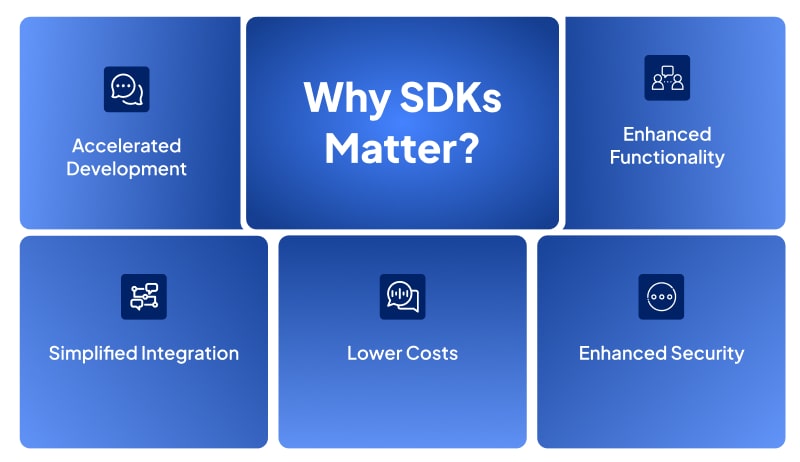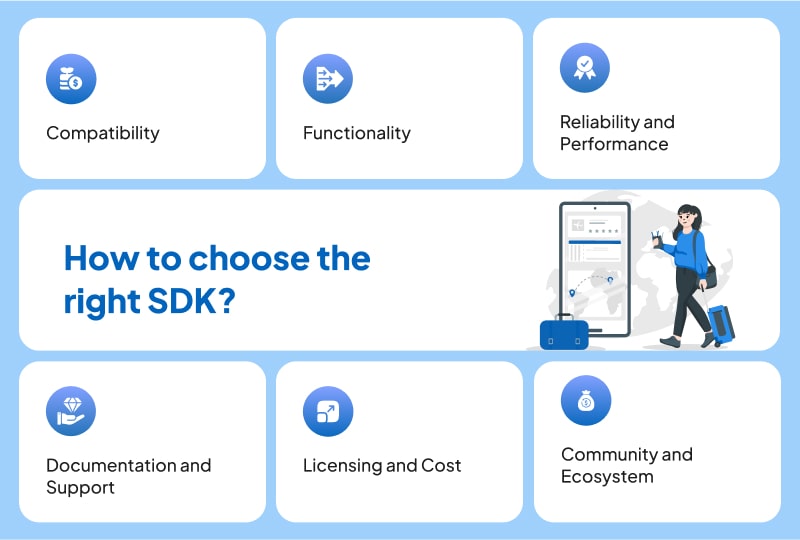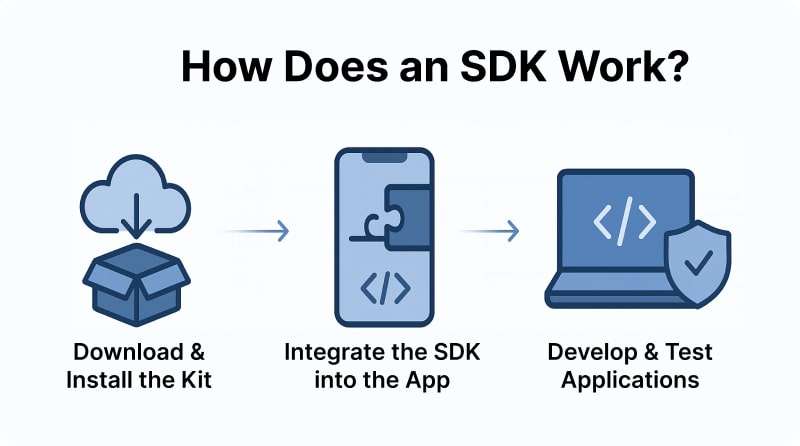
As the telecommunications space is rapidly evolving with advanced communication technologies, including VoIP and CPaaS, the demand for integrated communication features within applications has never been higher. Building telecom infrastructure from the ground up is complex, time-consuming, and expensive. SDKs for telecommunications change that game. Powering voice, video, and messaging capabilities into apps we use, software development kits or SDKs make it easy for developers to integrate real-time communication features into their apps without building them from the ground up.
Let’s explore how telecom SDKs work and how they’re powering the next generation of communication.
What is a Telecom SDK?
SDK is an abbreviation for Software Development Kit. At its core, it’s a toolbox for developers that provides them with the tools and instructions they need to build something specific. Many enterprise apps in various industries, especially healthcare, fintech, and logistics, use custom SDKs to embed secure communication features such as a video call function, messaging feature, or voice service inside an app.
In other words, we can say that an SDK is a pre-packaged bundle of resources that developers use to add new capabilities to apps. So if a company wants to add a chat feature to their app or system, the developers can simply plug in an SDK and get a working feature. This means there’s no requirement to code everything from scratch.
A Common Developer Question
If you’re new to programming and scratching your head over SDKs, you’re not alone. One Reddit user recently asked something along the lines of:
Hello!
I’m new to the programming world and am having a hard time understanding SDKs and their use cases. To me, they just sound like API calls that are wrapped in code, giving instructions on what to do when receiving the API calls. Please correct me if I’m wrong. Also, if possible, what are some example use cases for SDKs that are commonly seen? TYVM in advance!
Source: Reddit
This is a great question, the one that hits on a common confusion among beginners.
SDKs and APIs can seem similar. Both are tools developers use to connect and communicate with external systems. But they’re not the same thing.
APIs (Application Programming Interfaces) tell you what you can do, i.e., the actions you can perform, but you still need to do the action, i.e., write the code that uses those APIs.
SDKs (Software Development Kits) tell you what you can do, plus how you can do it. You just follow the steps, and you’ve got a working feature.
Types of Telecommunications SDKs
SDKs are designed to support various communication features. So they come in various forms depending on the features they are designed for. Let’s take a look at them, one by one:
VoIP SDK
VoIP over IP SDK is designed to enable developers to embed internet-based voice calling functionality into applications. These SDKs make use of internet protocols like SIP, RTP, or WebRTC to transmit voice data packets between users. Some common features offered by VoIP SDKs include:
- Peer-to-peer audio calls
- Paid calls
- Crystal clear voice quality in low bandwidth
- Conference calls with multiple users
- Call recording with customized control
- Cross-platform calls to desktop, mobile app, or carrier network
Messaging SDK
These SDKs add messaging features such as SMS, in-app chat, or push notifications to the applications. Messaging SDKs provide APIs and libraries that handle message routing, delivery receipts, encryption, and chat UI components. Some of the most common features offered are:
- Individual and group chat
- File sharing
- Location sharing
- Push notifications
- Multilingual support
- Message broadcast
- Real-time data backup
- Animated GIFs
- Cross-platform messaging
- Proactive chat
- Auto sync when logged in from other devices
Video SDK
These SDKs enable video calling, video conferencing, or live streaming inside apps. By leveraging protocols like WebRTC, messaging SDKs establish real-time peer-to-peer or multiparty video connections.
Some common features offered by these SDKs include
- Peer-to-peer video calls
- Crystal clear voice quality in low bandwidth
- Video call recording to store, compose & retrieve in the cloud
- Multi-party video conferencing facility
- One-to-one or group video calls on browsers
Core Features of Telecom SDKs

We just learnt about the various types of SDKs and the common features they offer in brief. Let’s detail those essential features that make SDKs powerful tools for developers:
Libraries
Pre-built code packages that developers can reuse to speed up development without writing everything from scratch.
Debugging Tools
Utilities that help identify, trace, and fix errors in the application during development.
IDEs (Integrated Development Environments)
Development workspaces that combine editing, building, debugging, and testing in one interface.
Testing Frameworks
Tools that allow developers to test the functionality, performance, and reliability of their applications systematically.
Plugins
Add-ons that extend or enhance the capabilities of an existing SDK or IDE.
Sample Code
Ready-to-use code snippets or full examples that show how to implement SDK features quickly.
API (Application Programming Interface)
A set of rules and endpoints that allows the app to communicate with the SDK and external systems.
Key Benefits of Using Telecom SDKs

Software Development Kits offer developers a plug-and-play approach when it comes to building real-time communication into apps, saving them from the complexity of coding and saving them time and cost. Let’s learn about the most impactful benefits of SDKs
Faster Time to Market
Rather than tackling the entire development of these intricate functions, SDKs provide developers with pre-built modules that can be simply integrated and made live. In other words, SDKs reduce the app development time for companies. This benefit is highly advantageous in today’s fast-paced digital market, where speed is everything.
Lower Development and Maintenance Costs
Building telecom features from scratch is not an easy job. It takes a lot of resources, time, and cost. You’ll need to invest in specialized telecom engineers, set up server infrastructure, build complex backend logic, take care of the ongoing maintenance and security patches, as well as ensure compliance with global telecom regulations. But SDKs handle all these complexities, leaving you at complete peace of mind.
Simplified Integration
Another reason why SDKs have become a go-to in telecom is how easy they are to integrate. One doesn’t need to have deep technical knowledge just to set up a simple voice call or message feature. Modern SDKs are designed keeping in mind friendliness. These toolkits come with clean documentation, ready-to-use code samples, sandbox or test environments, and whatnot. So there’s everything you need, right there.
Enhanced Security & Compliance
When it comes to telecom, security is certainly a deal-breaker. It doesn’t matter which industry you are dealing in, your users expect one thing above all, i.e., privacy and protection. The good news? Most of the modern telecom SDKs come with built-in encryption and data protection measures. Reliable SDK providers take security very seriously, and that’s why they typically offer SDKs with:
- End-to-end encryption for voice, video, and messaging
- Secure APIs with authentication tokens and access control
- Data protection mechanisms, like at-rest encryption and tokenization
- Regular vulnerability scans and patches by the provider’s security team
Rich Features & Customization
From auto-reconnect logic to call recordings and chat histories, SDKs offer an extensive toolkit. Most are also customizable to match your brand’s look and feel. This gives you the flexibility to build unique user experiences without being locked into fixed templates.
Popular Use Cases Across Industries
SDKs for telecommunications are incredibly versatile. You name an industry, and you’ll find SDKs being used there. Have a look at some of the most common use cases in detail:
Healthcare
Telemedicine is increasingly in trend these days. Patients can now consult with doctors over secure video calls powered by video SDKs. Further, messaging SDKs are also used to send appointment reminders, lab test reports, and voice SDKs enable private audio consultations.
Banking
The operations of the banking and finance sector revolve around security and compliance. Messaging SDKs provide an efficient and secure way for banks to send instant alerts about transactions to their customers. Customer-agent calls in the banking sector also need to be secure, which is why voice SDKs offering masked calls are often used to maintain privacy without compromising convenience.
Ecommerce
The world of e-commerce moves at a rapid rate. Customers want instant updates, personalized interactions, and seamless support as they move across the different stages of their buying journey. And that’s exactly where telecom SDKs play their role. Messaging SDKs are heavily used to keep customers informed about their order status in real-time, in the form of SMS or in-app push notifications.
Moreover, voice SDKs are useful in enabling customers to connect with agents directly from the app over VoIP calls. And because these calls happen over data, not the regular phone network, they can be recorded, analyzed, and optimized for better service quality.
The best part? Some of the leading e-commerce brands these days are going beyond text and calls; they’re using video SDKs to create more immersive shopping experiences. Live product demos, influencer-led shopping, and even video-based customer support are changing the game.
Logistics and Transportation
Let’s not forget logistics and transportation space. Modern ride-sharing apps use voice SDKs for call masking between drivers and passengers. Moreover, messaging SDKs are used to send real-time delivery updates, while CPaaS SDKs are used to verify phone numbers and enable secure driver logins. All in all, SDKs help in keeping things running smoothly by enabling better coordination and transparency.
How to Choose the Right Telecom SDK?

If you, too, are planning to develop an app and are looking for the right set of SDKs, don’t simply tick off the features. Rather, define your app goals, consider your development resources, and figure out your user expectations.
Assess Your Specific Communication Needs
As a fundamental rule, you should always start with the basics. So, ask yourself: What do you need the SDK to do? Are you looking to add voice calling, video conferencing, SMS, WhatsApp messaging, or real-time chat? Answering these questions would help you figure out what exactly you need.
Look for Multi-Channel Support
In an era where the consumer is the king, you need to provide what they need. Today’s users expect to communicate on their terms, whether that’s via in-app chat, voice calls, or even WhatsApp. Therefore, choose an SDK that supports multi-channel communication. This means getting a unified SDK that includes voice, video, and messaging features, all in the same kit.
Developer-Centric Integration Experience
Though SDKs are meant to speed up the development cycle of an app, it is, however, important to ensure that the SDK you choose comes with clear documentation, sample code, and developer support to speed up integration. Always remember that time is money, and having an SDK with plug-and-play APIs and ready-made UI components cuts development time in half.
Optimized for Growth and Efficiency
You might be targeting a small user base at the moment; however, as your user base grows, you’ll need an SDK that can scale along. So choose the one that offers reliable uptime, global coverage, and low-latency performance
Enterprise-Grade Protection and Compliance
In industries like healthcare and finance, where there’s a lot of sensitive data present, security is simply non-negotiable. Therefore, look for SDKs that offer end-to-end encryption and fraud protection.
Pricing Structure and Cost Overview
Many SDKs are available in hosted models, while others are available as licensed deployments. This means you can choose between a monthly payment or a one-time complete payment, depending on your budget and suitability.
Getting Started with a Telecom SDK

Getting started with the right telecom SDK is easier than it may sound; you just need to ensure the right approach. Since not all SDKs are created equal, you will need to look for a provider that offers:
- Good documentation and developer support
- Language compatibility
- Scalability and reliability
- Features aligned with your use case
REVE Voice, Video, and Messaging SDK is a reliable and popular solution if you are looking to integrate voice, video, and messaging capabilities into your app. For a quick demo or free trial, register here.
Conclusion
For developers and businesses alike, SDKs provide a fast track to integrating complex telecom functions into applications without the burden of building and maintaining infrastructure from scratch. With built-in security, cross-platform support, and scalability, they significantly lower the barrier to entry while improving performance and reliability.
Whether you’re building voice, video, or messaging applications, REVE’s telecom SDKs give you the scalability, flexibility, and reliability you need to stay ahead. You can connect with our team to explore how our SDKs can power your next big idea.
Frequently Asked Questions
Can I use multiple SDKs in one app?
Absolutely, it’s a common practice to use multiple SDKs in a single app. For example, you might be using a messaging SDK for chat, a voice SDK for voice calls, and a video SDK for video calls – all in a single app. It is essential to ensure that these SDKs are compatible and can work together.
What languages are supported by telecom SDKs?
Telecom SDKs support multiple languages. Some of the most common ones are Java, Kotlin, Swift, Objective-C, JavaScript, TypeScript, C# / .NET, Python, PHP, Node.js, etc. You can check the SDK documentation to know which languages it supports.
Are telecom SDKs secure?
Yes, modern telecom SDKs are developed with security in mind. Reliable SDK providers implement security measures, including End-to-End Encryption, Auto Message Deletion, AES Encryption, Fingerprint Lock, etc.
What’s the difference between a telecom API and an SDK?
An API lets you interact with a service by sending and receiving data through predefined calls. An SDK, on the other hand, is a toolkit that includes APIs plus additional resources such as pre-written code, libraries, documentation, and even UI components.
What types of apps use telecom SDKs?
Telecom SDKs are used in a wide variety of apps across industries, including Messaging and VoIP apps, Customer support platforms, Telemedicine apps, E-commerce platforms, Banking and fintech apps.






















